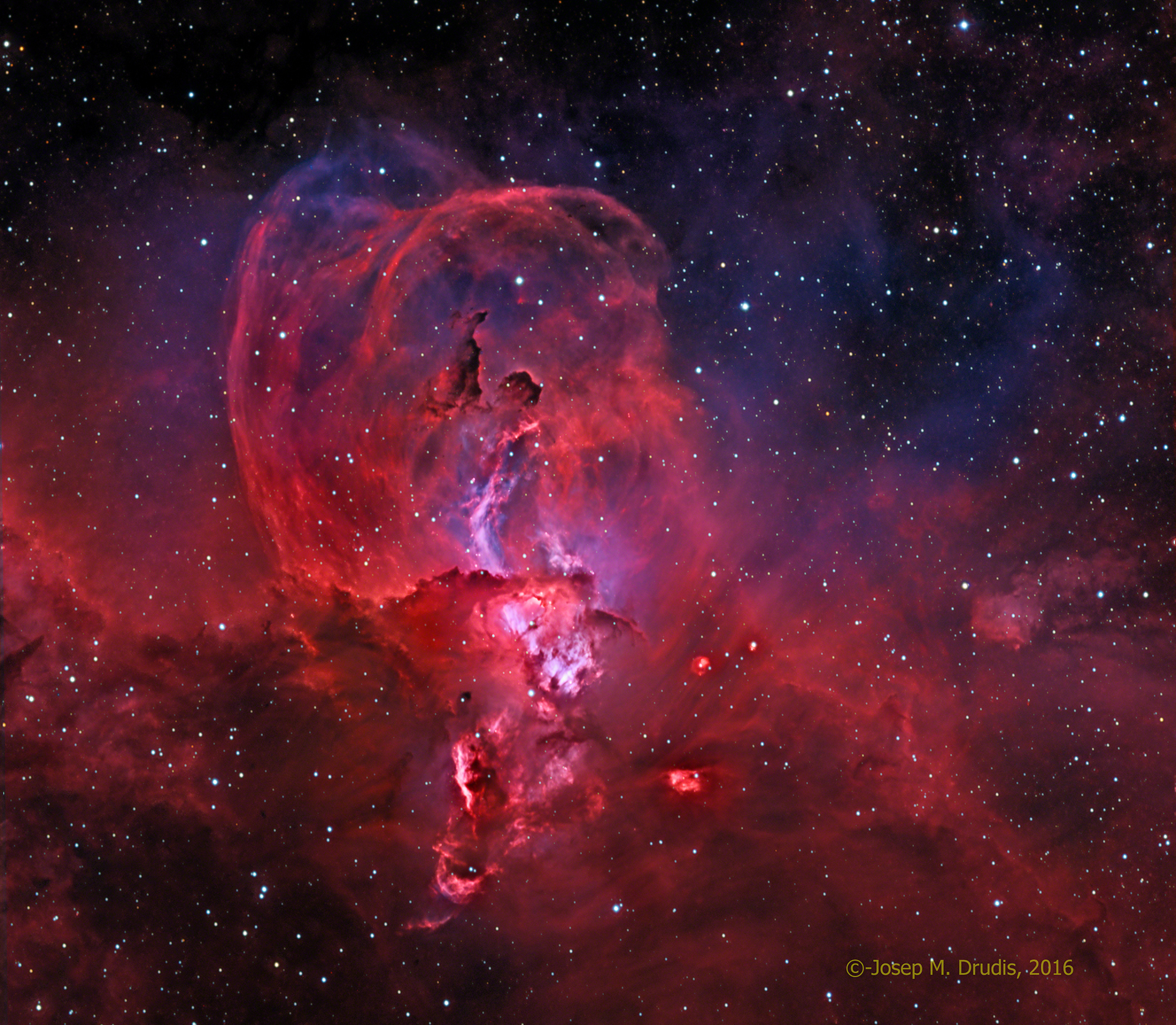
Click here for full resolution image
NGC 3576 is usually shown in wider field images, also containing NGC 3603, the nebula located immediately left of NGC 3576. Both nebulas are completely unrelated, being NGC 3576 at an approximate distance of 9,800 light years, while NGC 3603 is more than twice that distance. This picture has been taken exclusively in narrowband (Halpha, OIII and SII, RGB having only been used to image the stars) and processed in a way as to reproduce the visible spectrum of this nebula. Its name was first used by Dr. Mazlin due to the shape of its central part.
NGC 3576 is a large emission nebula and an active star formation region, more than 100 light years across. Would it be at the Orion nebula distance (8 times closer), this nebula would span more than 4 degrees in the sky (eight times the full Moon). In this nebula can be found many Bok globules (seen as small dark nebulae, the Bok globules typically have a mass of about 50 solar masses and are the birthplace of many massive stars). NGC 3576 is part of the Carina nebula complex and it shows complex loops. According to the General Catalogue of Herbig-Haro Objects (Reipurth+, 1999), there are no Herbig-Haro objects in this nebula.
This image has been selected as AAPOD (Amateur Astronomy Picture of the Day) on October 20, 2016: http://www.aapodx2.com/2016/20160720.html
Additional Information
Object
Name(s): NGC 3576. The Statue of Liberty Nebula
Type: Emission Nebula
RA: 11h 12m 02s
Dec: -61º 13’ 46”
Constellation: Carina
Size (arcmin): 16×27
Magnitude: +9.1
Distance: 9,800 ly
Image
Date: 2016-04-23 thru 2016-05-23
Location: iTelescope.net, SSO near Coonabarabran, NSW Australia
Size (arcmin): 37×32
Telescope: Planewave CDK 20” f/6.8
Camera: SBIG STX16803 (4096x4096pix)
Guiding: Astrodon MonsterMOAG off-axis guider
Total exposure: 24 hs (Ha: 5hs; OIII: 6.5hs; SII: 10.5hs; RGB 2hs)
Processing: CCDStack, Photoshop CC 2016 and PixInsight
Thanks for sharing
This is all fantastic how can I get more information about these Astro images and how to photograph them?
Thanks for the feedback
Maurice
Thanks for your comment, Maurice, I am pleased to know that you are interested in astronomical photography. In order to get more information about the objects that are on the images, just google the name of one of them and you will get plenty of pages that will give you thorough information.
Taking the images is another, a bit more complicated, story. You need an imaging equipment (telescope, mount, camera, computer and plenty of additional accessories (hardware as well as software) that help to take the images flawlessly) as well as the software tools to process the images you get and transform them into what you see in my web site. First you need to know what type of objects you want to image (just skyscapes, wide field astrophotos of large objects or smaller deep-sky objects that need longer focal length telescopes). Describing all this would take, probably, a small book. If I may, I suggest you contact a local astronomy association/club and there you will find people that can help you to find the right equipment for you as well as introducing you to the processing methods and software that are suitable for that purpose. Should you need some help finding a close astronomy association or a larger one not far from where you live, please just send me another message/comment and I will help you.